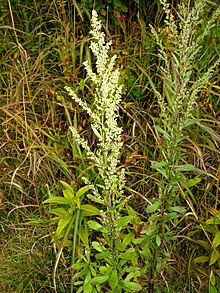Artemisia japonica
Artemisia japonica, commonly known as the Japanese wormwood or the Oriental wormwood, is a species of wormwood in the family Asteraceae that is native to Japan, Korea, China, Southeast Asia, and the Indian Subcontinent.[1] Its common name in Japanese is オトコヨモギ, 牡蓬, or otoko yomogi meaning male mugwort in English.[2]
| Artemisia japonica | |
|---|---|

| |
| Scientific classification | |
| Kingdom: | Plantae |
| Clade: | Tracheophytes |
| Clade: | Angiosperms |
| Clade: | Eudicots |
| Clade: | Asterids |
| Order: | Asterales |
| Family: | Asteraceae |
| Genus: | Artemisia |
| Species: | A. japonica
|
| Binomial name | |
| Artemisia japonica | |
| Synonyms | |
|
Chrysanthemum japonicum (Thunb.) Draconia japonica (Thunb.) Oligosporus japonicus (Thunb.) | |
Description
It is a perennial herb growing up to 50-130 centimeters. The rootstock is thick, woody, and has a strong smell. The leaves are clustered at the rounded apex. The leaf blade is spatulate and oblong-obovate to broadly spatulate or flabellate. The achenes are brown and obovoid.[3] The flowering is from August to November.[2] It is most commonly found in the months of August, September, and October. 82.3% of the time it was found it was a preserved sample, and 17.0% of the time it was observed by humans. It is most commonly found in the countries of China, Japan, and Korea.[4]
Artemisia japonica has four subspecies:[4]
Artemisia japonica var. hainanensis native to China.
Artemisia japonica var. hallaisanensis native to Korea.
Artemisia japonica var. japonica native to Japan.
Artemisia japonica var. manshurica native to Northeastern China.
Uses
The young leaves are cooked and eaten. The adult leaves are used as a digestive. A decoction of the leaves can give hypertension if eaten too much. The juice from the plant is used to treat vaginitis and skin diseases.[5] The powder from drying the plant is used as an incense.[6] It is used in making antitoxifying and antifebrile drugs.[7]
Ecology
Globodera artemisiae, a parasite, was first found on Artemisia japonica in September 2020. The parasite is commonly found on Artemisia vulgaris.[8]
References
- ^ "Artemisia japonica Thunb. | Plants of the World Online | Kew Science". Plants of the World Online. Retrieved 9 August 2023.
- ^ a b "Artemisia japonica Thunberg". flowers.la.coocan.jp. Retrieved 10 August 2023.
- ^ "Artemisia japonica Thunb". worldfloraonline.org.
{{cite web}}: CS1 maint: url-status (link) - ^ a b "Artemisia japonica Thunb". www.gbif.org. Retrieved 10 August 2023.
- ^ "Artemisia japonica PFAF Plant Database". pfaf.org. Retrieved 10 August 2023.
- ^ "Artemisia japonica - Useful Temperate Plants". temperate.theferns.info. Retrieved 10 August 2023.
- ^ "Artemisia japonica - Practical Plants". practicalplants.org. Retrieved 10 August 2023.
- ^ Jiang, Ru; Li, Yunqing; Huang, Liqiang; Peng, Huan; Peng, Deliang (2020-11). "First Report of Globodera artemisiae on Artemisia japonica from Guizhou and Yunnan Provinces, China". Plant Disease. 104 (11): 3083–3083. doi:10.1094/PDIS-04-20-0874-PDN. ISSN 0191-2917.
{{cite journal}}: Check date values in:|date=(help)
